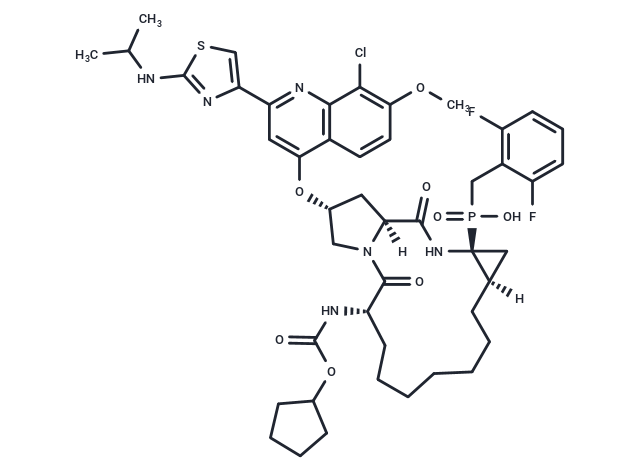Shopping Cart
- Remove All
 Your shopping cart is currently empty
Your shopping cart is currently empty

GS-9256 is a selective inhibitor of the HCV NS3 protease, exhibiting favorable pharmacokinetic properties and antiviral activity [1].

| Pack Size | Price | Availability | Quantity |
|---|---|---|---|
| 25 mg | $1,520 | 6-8 weeks | |
| 50 mg | $1,980 | 6-8 weeks | |
| 100 mg | $2,500 | 6-8 weeks |
| Description | GS-9256 is a selective inhibitor of the HCV NS3 protease, exhibiting favorable pharmacokinetic properties and antiviral activity [1]. |
| In vitro | GS-9256 demonstrates potent antiviral activity with a mean EC50 of 20 nM across a concentration range of 0.002-0.183 μM in GT1b huh-luc cells harboring a luciferase-encoding replicon [1]. Furthermore, at 3 μM, GS-9256 maintains efficacy against all tested resistant mutations in NS5B and NS5A inhibitors, showcasing its metabolic stability in microsomes and hepatocytes from rodents, dogs, and humans [1]. |
| In vivo | GS-9256 exhibits high bioavailability in mice (approximately 100%) when administered intravenously at 1 mg/kg with a 30-minute exposure, while showing moderate bioavailability in rats (14%), dogs (21%), and monkeys (14%). The compound's elimination half-life spans approximately 2 hours in mice, 0.6 hours in rats, 5 hours in dogs, and 4 hours in monkeys. Regarding the pharmacokinetic parameters at indicated doses for each species (IV: 2 mg/kg in mice, 1 mg/kg in rats, dogs, and monkeys; Oral: 50 mg/kg in mice, 5 mg/kg in rats and monkeys, and 4 mg/kg in dogs), they are as follows: for the CD-1 mouse, Sprague-Dawley rat, Beagle dog, and Cynomolgus monkey, the clearance (CL) is 2.0, 1.26, 0.04, and 0.33 L/h/kg respectively, while the volume of distribution at steady state (Vss) is 2.3, 0.16, 0.09, and 0.27 L/kg respectively [1]. |
| Molecular Weight | 957.46 |
| Formula | C46H56ClF2N6O8PS |
| Cas No. | 1001094-46-7 |
| Storage | Powder: -20°C for 3 years | In solvent: -80°C for 1 year | Shipping with blue ice. |

Copyright © 2015-2025 TargetMol Chemicals Inc. All Rights Reserved.